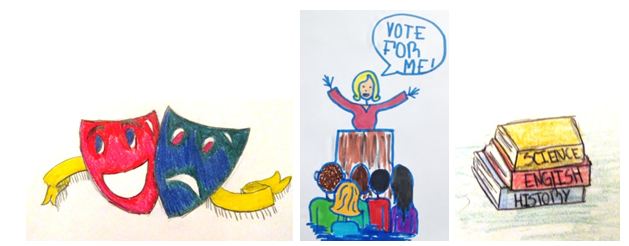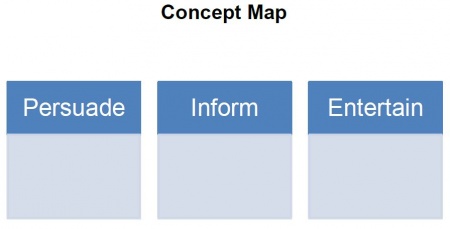Author's Purpose and Point of View Content Module
BACK TO Content Modules
Contents |
Plot the Course
CCSS.ELA-Literacy.CCRA.R.6 Assess how point of view or purpose shapes the content and style of a text.
The rationale
Determining the author's purpose and the point of view of a text can help students deepen their understanding of what they read and read with a critical lens. These are lifelong skills readers need when critically analyzing text to distinguish different perspectives and/or determine propaganda.
Module Goal
The goal of this module is to provide detailed information on author's purpose and point of view to teachers of students with disabilities at the elementary and middle school level. This module aims to provide teachers with a general overview of these concepts as well as teaching suggestions so that a teacher can begin to plan instruction for these concepts. Additionally, this module provides instructors with potential adaptations and modifications to consider when designing materials and instruction for students with severe disabilities.
Module Objectives
After viewing the content module, teachers will:
- Develop a deeper understanding of author's purpose and point of view as proficient reader strategies.
- Learn instructional strategies for teaching students author's purpose and point of view when reading to enhance comprehension.
This module is organized using the following sections: Time for Take Off, Floating on Air, and Prepare for Landing. Key vocabulary is provided in the "Time for Take Off" section of the module. Connections to the Common Core State Standards and PowerPoint presentations containing information and instructional suggestions for teaching author's purpose and point of view are shared in the "Floating on Air" component. In "Prepare for Landing", strategies to review, reinforce, and apply author's purpose and point of view to real world connections are provided.
Time for Take Off
Understanding the vocabulary used when learning about author's purpose and point of view is important for both teachers and students in planning and implementing reading lessons. As a teacher, knowing and using the terms not only ensures your instruction stays true to the content, but will also help with collaborating with other reading teachers or literacy experts. When choosing which vocabulary to teach, it is most important that the teacher selects the most salient, important, or most frequently used vocabulary for each lesson.
Below you will find a list of vocabulary related to this module. It may or may not be necessary to provide instruction for all terms as students may have learned them previously. If you are a secondary teacher and are not confident your students have been taught these vocabulary terms, you may want to review and teach those unknown terms during the focus and review section of your lesson plan.
While providing vocabulary instruction, you may consider including pictures or objects to make the instruction more concrete for students with disabilities (See Ideas to support vocabulary learning below).
Vocabulary
- characters - person/persons in a story
- setting - place where the story happens
- plot - sequence of events involving characters in conflict situations
- point of view - perspective from which the story is told
- first person point of view - a character is the narrator who tells the story
- third person point of view - story is told by an outside observer who is not in the story
- author's purpose - the reason an author writes something
- inform - to teach
- entertain - to enjoy, for pleasure, usually a story
- persuade - to convince someone
Idea to support vocabulary learning
Use visual representations or actions to explain author's purpose and point of view and their terms. For example, the following images may be shared to teach author's purpose.
Floating on Air
Before you can begin teaching your students about author's purpose and point of view, it is important that you first have a deep understanding of the information. Some of the concepts may be familiar to you. Below is a list containing Standard R.L.6 and R.I. 6 from the Common Core State Standards for grades K-8. You will also find a series of PowerPoint presentations containing information, examples, and instructional suggestions for teaching author's purpose and point of view below the chart.
ELA Common Core State Standard 6: Author's Purpose and Point of View - Grades K-8
| K | RL.K.6. With prompting and support, name the author and illustrator of a story and define the role of each in telling the story.
RI.K.6. Name the author and illustrator of a text and define the role of each in presenting the ideas or information in a text. |
| 1 | RL.1.6. Identify who is telling the story at various points in a text.
RI.1.6. Distinguish between information provided by pictures or other illustrations and information provided by the words in a text. |
| 2 | RL.2.6. Acknowledge differences in the points of view of characters, including by speaking in a different voice for each character when reading dialogue aloud.
RI.2.6. Identify the main purpose of a text, including what the author wants to answer, explain, or describe. |
| 3 | RL.3.6. Distinguish their own point of view from that of the narrator or those of the characters.
RI.3.6. Distinguish their own point of view from that of the author of a text. |
| 4 | RL.4.6. Compare and contrast the point of view from which different stories are narrated, including the difference between first- and third-person narrations.
RI.4.6. Compare and contrast a firsthand and secondhand account of the same event or topic; describe the differences in focus and the information provided. |
| 5 | RL.5.6. Describe how a narrator's or speaker's point of view influences how events are described.
RI.5.6. Analyze multiple accounts of the same event or topic, noting important similarities and differences in the point of view they represent. |
| 6 | RL.6.6. Explain how an author develops the point of view of the narrator or speaker in a text.
RI.6.6. Determine an author's point of view or purpose in a text and explain how it is conveyed in the text. |
| 7 | RL.7.6. Analyze how an author develops and contrasts the points of view of different characters or narrators in a text.
RI.7.6. Determine an author's point of view or purpose in a text and analyze how the author distinguishes his or her position from that of others. |
| 8 | RL.8.6. Analyze how differences in the points of view of the characters and the audience or reader (e.g., created through the use of dramatic irony) create such effects as suspense or humor.
RI.8.6. Determine an author's point of view or purpose in a text and analyze how the author acknowledges and responds to conflicting evidence or viewpoints. |
Deepen your understanding. Click on each PowerPoint below.
Great! Now that you have viewed the PowerPoint presentations, the next section will provide some ideas to consider when planning for Universal Design for Learning.
Sharing the Sky
UNIVERSAL DESIGN FOR LEARNING
| Visual Impairment or Deaf/Blind | Physical Impairment:
Little/ No Hand Use |
Lacks Basic Concepts | Motivational/ Attention Issues | |
| Representation | Use a talking device such as an avatar; use large print text, raised text or Braille, use objects and images to represent the author's purpose or point of view; use online tools to create graphic organizers (i.e., Readwritethink.org); Use picture cards and graphic organizers to represent the author's purpose or point of view. | Student scans an array of possible options and uses a switch to select the correct answer when asked a question pertaining to a given text; use computer representation of key aspects of the text that can be manipulated with switch; place key aspects of the text on a slant board or eye gaze board; create an exercise in the classroom that the student can walk or ride in wheelchair to find the author's purpose or point of view of a text. | Use appropriate and accessible text. Rewrite text to simplify plot and details. Include additional images and illustrations to help convey the meaning of the text. Provide students with graphic organizers and sentence starters. Highlight key words within the context of the print. | Use motivating objects and topics to determine the author's purpose or point of view (i.e., puppets, etc.). Incorporate technology including computer representations, videos, animations, and talking avatar. Allow students to self-select text of interest. |
| Expression | Student states answer; use voice output devices for student to select the correct answer; teach tangible symbols for key phrases (i.e., entertain, persuade, inform, etc.) | Uses a switch to indicate correct answers; use an eye gaze board to select answer; use a blink response to select answer; phrase questions so that they require a "yes/no" response, these can easily be answered using an eye gaze, head turn, two switches, etc. | Student selects pre-made cards with author's purpose or point of view versus writing a response; selection of correct answer is done after a model; student answers "yes/no" questions. | Have students find the author's purpose or point of view with images, drawing, interactive computer programs, etc. |
| Engagement | Teach students to use their hands to scan objects; use talking avatars or read aloud of text; start with simple, large print text and online interactive text; use text featuring topics and characters that are familiar and reinforcing to students. | Use bright colors to call attention to key words; use a computer with AT where the student can click to answer; use cards that are large enough to accommodate the movements that the student is able to make; pair student with another student without a physical impairment and have them work together to find the author's purpose and point of view. | Student uses websites and listening centers that read aloud text. Use bright colored stickers or sticky notes to mark key words within text. Use puppets, objects, and picture cards to find the author's purpose and point of view. Explicitly model using think alouds along with visual images and actions. | Create games in which students interact with partners to find the author's purpose and point of view using cards with images. Create stories and text that involve the students and their personal interests and experiences. |
Concept Map
Prepare for Landing
Below you will find ideas for linking author's purpose and point of view to real-world applications, the college and career readiness skills addressed by teaching these concepts, module assessments for teachers, sample general education lesson plans incorporating Universal Design for Learning framework, blog for teachers to share their ideas, and a place to upload and share lesson plans from teachers who completed this module. One way to help assist in a special educator's development within this curricular area is through collaboration with other teachers in your building. Often these skills are practiced outside of an ELA classroom in other curricular areas as well as during everyday tasks. Some activities with real world connection include:
- Associate the skills of author's purpose and point of view to wide reading and real world texts. This allows the students to apply the learning to real reading experiences. This supports students' meaning making process and will increase their reading comprehension.
- Students can also practice author's purpose and point of view skills when discussing TV shows, movies, advertisements, campaigns, speeches, etc.
In addition to the real-world applications of these concepts, skills taught within this content module also promote the following college and career readiness skills.
Communicative competence Students will increase their vocabulary to include concepts related to "author's purpose" and "point of view." Specifically, they will learn to use language such as, "I am thinking…" "The author's purpose is to…" and "The text is written from the point of view of…"
Fluency in reading, writing, and math Students will have opportunities to increase their fluency and comprehension as they develop their abilities to determine author's purpose and point of view. By having stronger proficiency with author's purpose and point of view, students will be able to process text more strategically and at a more fluent pace. They will also understand the text in greater depth.
Age appropriate social skills Students will engage in peer groups to determine the author's purpose and point of view of a range of texts.
Independent work behaviors Students will engage in independent reading. They will have increased opportunities to practice finding the author's purpose and point of view in the real-life reading context.
Skills in accessing support systems At times, students will need to ask for assistance to complete activities related to "author's purpose" and "point of view" which will give them practice in accessing supports. Students will gain practice asking for help with reading a range of diverse text as needed. They can ask a peer to complete the physical movements of the tasks they are not able to do themselves. Be sure to teach students to ask versus having items or supports automatically given to them.
In addition to collaborating with other educational professionals in your building, the following list of resources may also help provide special educators with ideas for activities or support a more thorough understanding of the concepts presented in this content module.
Additional Resources
Extra Special Teaching. Retrieved June 9, 2013 from http://extraspecialteaching.blogspot.com/2012/02/authors-purpose-im-pied-out.html This blog provides visuals for teachers of anchor charts that would support learning on author's purpose.
National Geographic Kids (2013). Retrieved June 16, 2013 from http://kids.nationalgeographic.com/kids/stories/ On this site, visit the news tab and have students determine what the author's point of view is: to inform, to entertain, to clarify, etc.
Time for Kids (2013). Retrieved June 16, 2013 from http://www.timeforkids.com/news. When viewing news stories on this site, have students determine what the author's point of view is: to inform, to entertain, to clarify, etc.
Tulare County Office of Education (2012). Retrieved June 6, 2013 from http://commoncore.tcoe.org/Home/Home. This website has bookmarks for grades K-12 listing the anchor standard, related essential skills and concepts, question stems and prompts, and academic vocabulary.
YouTube- Author's Purpose from Comprehension Learning Upgrade (2006). Retrieved June 10, 2013 from http://www.youtube.com. This YouTube video discusses the five forms of author's purpose.
Author's Purpose Reading Comprehension Practice Cards-http://www.amazon.com
Author's Purpose Bulletin Sets-http://www.amazon.com
Point of View 35 Reading Passages for Comprehension-http://www.amazon.com
References
Silver, H. F., Dewing, R. T., & Perini, M. J. (2012). The core six: essential strategies for achieving excellence with the common core. Alexandria, VA; ASCD.
Module Assessments
Below are links to assessments for the purpose of self-checking your understanding of the content in this module. After answering the assessment questions, you may want to review the key to check your work.
Author's Purpose and Point of View Assessment
Author's Purpose and Point of View Assessment Key
Sample General Education lesson plans
ReadWorks.org (2013). Retrieved June 7, 2013 from http://www.readworks.org/lessons/concepts/point-view. This site provides units on Point of View with a series of sample lessons.
ReadWriteThink (2013). Retrieved June 9, 2013 from http://www.readwritethink.org/classroom-resources/lesson-plans/teaching-point-view-with-789.html. This lesson allows teachers of grades 3-5 to teach Point of View through the text of Two Bad Ants.
Scholastic (2013). Retrieved June 15, 2013 from http://www.scholastic.com/browse/search/teacher?query=author%27s+purpose&as_values_043=&channelOnly=true. Scholastic offers author's purpose lesson plan ideas for teachers as these lessons are based around a variety of books.
Study Zone (2011). Retrieved June 7, 2013 from http://www.studyzone.org/testprep/ela4/o/pointofviewp.cfm. This site is interactive allowing students to determine whether what is written is in first or third person point of view, providing instant feedback on their answer choice.
University of Missouri Themes (2012). Retrieved June 7, 2013 from http://ethemes.missouri.edu/themes/1895. This site provides teachers and students lists of books to refer to as they focus on author's purpose.
Utah Education Network. Retrieved June 9, 2013 from http://www.uen.org/core/. UEN has provided sample lessons on author's purpose and point of view with additional links for support to the lessons and learning.
Adapt the following general education lesson plan; adapt, and upload. These lesson plans may be shared with higher education professionals developing strategies to provide meaningful academic instruction in ELA to students with severe disabilities.






